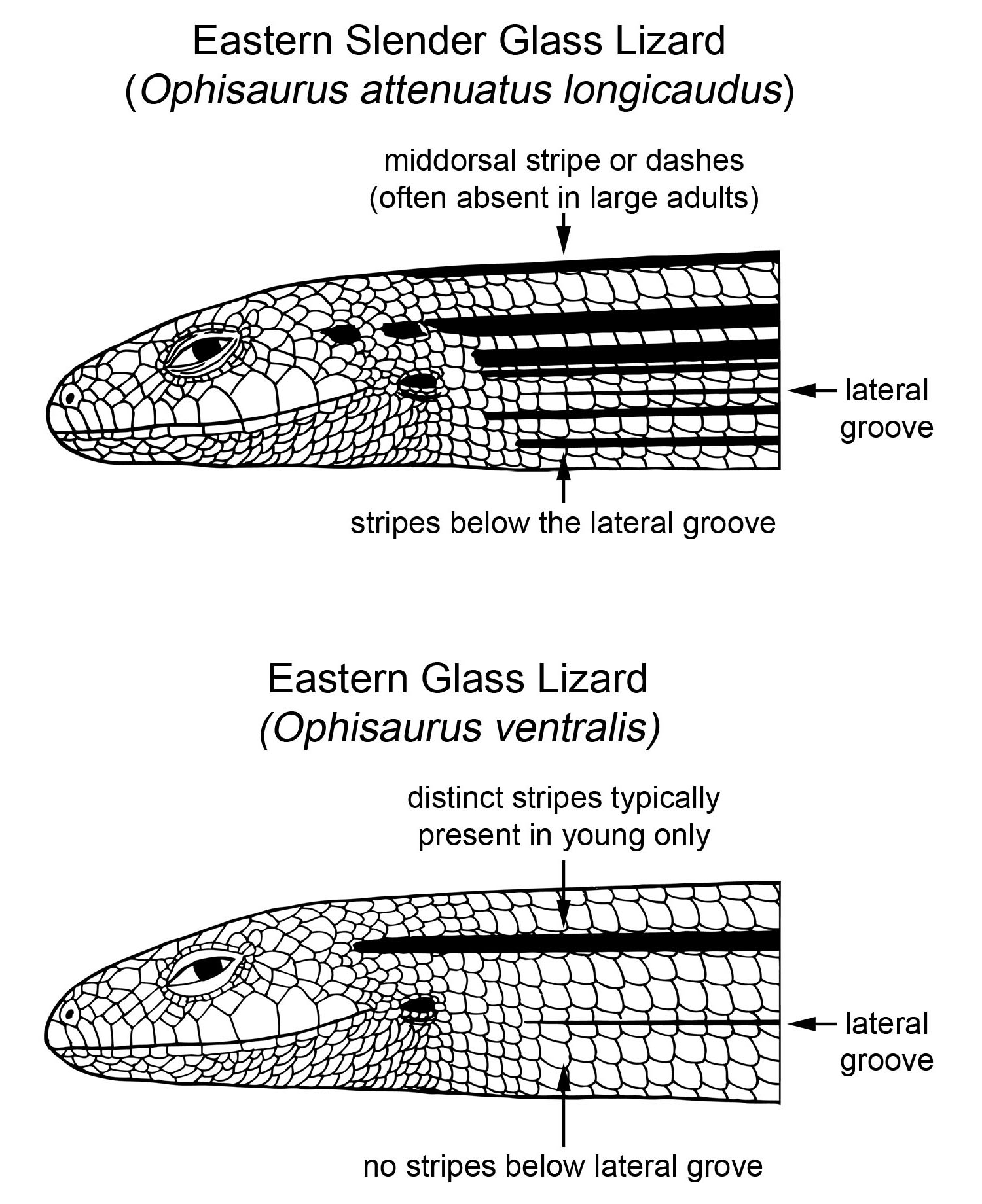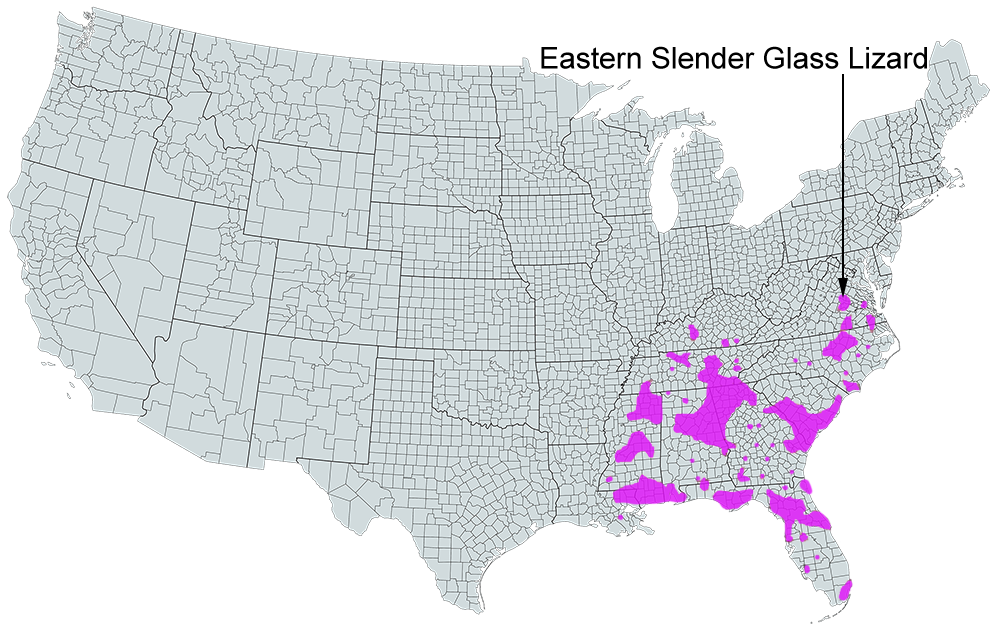Eastern Slender Glass Lizard
Ophisaurus attenuatus longicaudus
Common Name: |
Eastern Slender Glass Lizard |
Scientific Name: |
Ophisaurus attenuatus longicaudus |
Etymology: |
|
Genus: |
Ophisaurus is derived from the Greek words ophio meaning "snake" and sauros meaning "lizard". |
Species: |
attenuatus is Latin for "tapered" or "thin". |
Subspecies: |
longicaudus consists of the Latin words longus meaning long and cauda meaning tail. |
Average Length: |
22 - 42 in. (56 - 106.7 cm) |
Virginia Record Length: |
32.3 in. (94.7 cm) |
Record length: |
42 in. (106.7 cm) |
Systematics: This species was originally described as a subspecies of Ophisaurus ventralis ("Opheosaurus ventralis attenuatus") by Spencer Fullerton Baird in Cope (1880). A type specimen was not specified until McConkey (1954) designated one (a neo-type) from Texas. Boulenger (1885) first used the combination Ophisaurus attenuatus and the current spelling of the genus. Two subspecies are recognized: O. a. attenuatus Cope and O. a. longicaudus McConkey. The latter was described by Edwin Henry McConkey (1952) from a specimen collected in Baker County, Georgia, in 1948; this subspecies occurs in Virginia. It was not until McConkey's (1954) revision of the genus, however, that it was understood that the species referred to as O. ventralis in the early Virginia literature (e.g., Dunn, 1936; Brumfield, 1937; Carroll, 1950; Werler and McCallion, 1951) was actually O. a. longicaudus.
Description: A legless, snakelike lizard reaching a maximum snout-vent length (SVL) of 330 mm (13.0 inches) and a maximum total length of 1,065 mm (41.9 inches) (Mount, 1975). In Virginia, known maximum SVL is 415 mm (16.3 inches, preserved measurement) and maximum total length is 947 mm (32.3 inches). Tail length/total length in the present study was 69.0% (n = 2 with complete tails); when complete, the tail was longer than 2.1 x SVL. A deep, lateral groove is present on each side of the body.
Scutellation: Scales smooth, squarish to rhomboidal in shape, overlapping, and glossy; scale rows around midbody between lateral grooves 14-17 (ave. = 14.8 ± 1.1, n = 15); number of ventral rows 10; ventrals 103-138 (ave. = 115.4 ± 8.8, n = 15); scales along lateral groove 104-114 (ave. = 108.5 ± 2.8, n = 15); infralabials usually 10/10 or 11/11 (69.2%, n = 13), 12/12 (23.1%), or combinations of these (7.7%); supralabials usually 11/11 (71.4%, n = 14), occasionally 12/12 (21.4%), or combinations of these (7.1%); supranasals present; frontonasal separated from rostral; preanal scales 8; mental single; postmentals 2.
Coloration and Pattern: Dorsum with a tan stripe (6 scales wide at midbody) extending from snout to tip of tail; a narrow dark-brown to black middorsal stripe bisects the tan stripe (may not be present in large adults); adults may have cross-bands of irregular black-and-white spots that connect middorsal stripe with lateral stripes; lateral stripes above lateral groove either mottled black or brown and white, or alternating distinct dark- brown or black-and-white stripes; 2 white stripes laterally in which white pigment is confined to lower half of scales; 1 to 2 narrow black or brown stripes occur below lateral groove; venter of body immaculate cream; venter of tail cream and either patternless or with 4 incomplete dark-brown stripes. Adults often possess a shallow groove along the middorsal line and slightly ridged dorsal scales that form a series of longitudinal ridges. The fragile tail is often broken and the regenerated portion is uniformly colored light brown.
Sexual Dimorphism: Adult males (265-415 mm SVL, ave. = 303.5 ± 48.7, n = 14) were larger than adult females (260-290 mm SVL, ave. = 274.0 ± 15.1, n = 3). Sexual dimorphism index was -0.11. The number of scales along the lateral groove in females (107-108, n = 2) was similar to the number in males (104-114, ave. = 108.7 ± 3.1, n = 12). There appear to be no differences in pattern or color in Virginia specimens.
Juveniles: Juveniles are generally patterned as adults, but the dark middorsal stripe is more prominent. Size at hatching is unknown in Virginia. Fitch (1989) found an average of 56.8 mm SVL (50-63) for a sample of 64 hatchlings in Kansas.
Confusing Species: This species may be confused only with the other legless lizard in Virginia, Ophisaurus ventralis, which lacks the black stripes below the lateral groove. Unlike O. attenuatus, it has several white vertical lines outlined in black behind the eye.

Geographic Variation: Lack of specimens precludes an analysis of geographic variation in Virginia. McConkey (1954) listed an average of 106.3 ± 2.7 (101-113, n = 50) scales along the lateral groove from samples throughout the range of this species. The data from the small sample of Virginia specimens overlap neatly with these values.
Biology: This lizard occupies grassland habitats occurring on dry, well-drained soils. It occurs in dry pine woods in the Coastal Plain and in association with grass habitats on dry ridges in the Piedmont. Glass lizards occasionally turn up in urban and suburban areas and around farms, but always in association with grassy areas. They are secretive and seldom seen because they stay in abandoned rodent burrows and under mats of dead grass and other decomposing plant material. Fitch (1989) reported that individuals of O. attenuatus are low in numbers in areas with many shade trees and too little ground cover for shelter. Once old field succession reaches the stage where pine and hardwood trees shade the ground, glass lizards decline in numbers. All Virginia specimens were caught March through October; 7 of 18 were in June. These lizards overwinter underground. Eastern Slender Glass Lizard eat a variety of invertebrate prey (McConkey, 1954; Fitch, 1989) but appear to prefer grasshoppers, perhaps because this is a common prey species in grassland habitats. Other prey include snails, spiders, caterpillars, beetles, cave crickets, and young of small mammals (Fitch, 1989). Crickets, grasshoppers, lycosid spiders, and unidentified mammal hair were found in three Virginia specimens.
Nothing is known about reproduction in O. attenuatus in Virginia. Courtship and mating behavior is unknown for this species, although Fitch (1989) noted head biting by a male and unsuccessful attempts to juxtapose his cloaca with hers. Male and female O. a. attenuatus in Arkansas matured at 150 mm SVL (Trauth, 1984). Females are oviparous and known to stay coiled about the eggs until they hatch, about 56-60 days after laying in the laboratory (Nobel and Mason, 1933). Two female specimens of O. a. longicaudus from Alabama contained 5 and 10 oviductal eggs (Mount, 1975). Fitch (1989) reported clutch sizes of 5-16 (ave. = 10.2 ± 3.0) for the midwestern subspecies in Kansas, and an average of 10.9 (5-16) for the species based on data in the literature. He also noted that eggs (16.0-20.0 x 7.0-9.0 mm) were laid from 24 June to 11 July and hatched in mid-August to early October.
In northeastern Kansas, Fitch (1989) found considerable variation (25-780) in annual numbers of glass lizards on a 7-hectare tract over a 37-year period. Annual juvenile survivorship was lower (42.6%) than that of subadults and adults (60%). Few survived more than 10 years. Growth was rapid in juveniles (9 mm per month) but slow in adults (1-2 mm per month).
These are active lizards. Body temperatures of active glass lizards were 23-35°C (Fitch, 1956). They often bask in open sun on the ground with only part of the body exposed. When caught, they whip back and forth vigorously, often breaking the tail off in the process (see "Remarks"). Large individuals can bite hard when caught.
Remarks: Other common names in Virginia are glass snake (Dunn, 1936; Carroll, 1950) and joint snake (Mitchell, 1990b).
The ability of glass lizards to autotomize their tails, often breaking into several pieces, has led to much folklore surrounding this species. Many people mistake this lizard for a snake because it lacks legs. Some claim that the broken pieces will grow back together after sunset and form a complete "snake" again. A series of notes in the Martinsville Daily Bulletin in September 1967 describe just such an incident, and the people involved claimed they saw the pieces reassembling. Perhaps they thought that the wriggling of the pieces indicated they were "trying" to reassemble. The fractured pieces cannot grow back together. Tail autotomy is an antipredator adaptation. Since most of the lizard is composed of the tail, a predator is more likely to grab it than the body. Fracture planes occur in various places and the whipping back and forth causes the tail to break along these planes. The lizard can grow another tail, although the regenerated portion is uniformly tan in color and is shorter than the original. Most glass lizards lack a complete, original tail.
Conservation and Management: The number of occurrences of this lizard in Virginia indicates that it does not warrant special concern status. However, many of the localities from which the vouchers came no longer have appropriate grassland habitat because of successional changes and direct loss. Habitat loss undoubtedly accounts for some historical decline in numbers. Reduction in numbers may also be due to loss of prey species from overuse of pesticides. Observations of any kind should be reported. Any consideration of long-term management for this species must include the maintenance of grassland habitat.
References for Life History
Photos:
*Click on a thumbnail for a larger version.
Verified County/City Occurrence on Virginia
Amelia
Brunswick
Chesterfield
Dinwiddie
Hanover
Isle of Wight
James City
King William
Louisa
Mecklenburg
New Kent
Powhatan
Surry
York
CITIES
Suffolk
Verified in 14 counties and 1 cities.
U.S. Range





